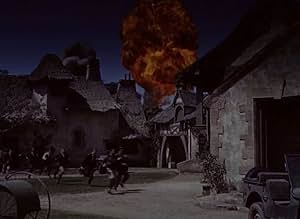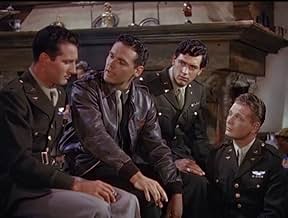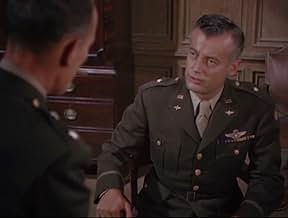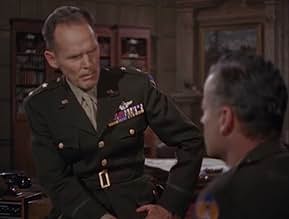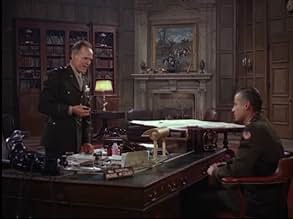IMDb RATING
6.2/10
1.1K
YOUR RATING
During World War II, an insubordinate fighter pilot finds the shoe on the other foot when he's promoted.During World War II, an insubordinate fighter pilot finds the shoe on the other foot when he's promoted.During World War II, an insubordinate fighter pilot finds the shoe on the other foot when he's promoted.
- Awards
- 2 wins total
Bill McLean
- Pvt. Wilbur
- (as William McLean)
George Adrian
- German Pilot
- (uncredited)
Robert Alderette
- Chappell's Crew Chief
- (uncredited)
Joel Allen
- Sentry
- (uncredited)
George Backus
- Sentry
- (uncredited)
Janet Barrett
- Chorine
- (uncredited)
Lilian Bond
- English Lady
- (uncredited)
- Director
- Writers
- All cast & crew
- Production, box office & more at IMDbPro
Featured reviews
A rollicking WWII film and a treat for fans of the P-47 Thunderbolt. The flying scenes are great and (if I remember correctly) one of the USAAF fighter pilots actually asks a question about who plays for the Dodgers in order to smoke out false orders radioed to the Group by the Germans. Worth a look-see.
The first thing that struck me about this movie was the quality of the color, which was excellent. It looked more like a movie made in the 50's than 1948. Like Mr. Padilla, who's informative review also appears in this database, I was momentarily baffled when the enemy planes first appeared in the movie. What's this?, I thought. I know those aren't Messerschmidts, and I recall the Stukas weren't that sleek-looking. What we have here are Mustangs in drag, as it were. I suppose the production company may have used whatever war birds they could lay their hands on. Chaulk one up for artistic license.
Once I got over that, I enjoyed the movie. Hollywood must have made a blue million war movies during and after WWII, and I own copies of at least 50 or so of them, but here's one I'd never seen before, nor even heard of. Most of the actors were pleasantly familiar, with Robert Stack being much younger here than I have before seen him. But towards the end of the movie, when all the pilots were gathered in the Ready Room before a mission, I had to do a double take as I looked at the members of the squad in the background. Is that who I think it is, I thought. Sure 'nuff, after the flick ended I came to this website to check the cast list, and there he was, listed as an unspoken actor, Rock Hudson.
I haven't yet searched to see if this movie is available on VHS or DVD, but I will. I'd like to own a copy.
Once I got over that, I enjoyed the movie. Hollywood must have made a blue million war movies during and after WWII, and I own copies of at least 50 or so of them, but here's one I'd never seen before, nor even heard of. Most of the actors were pleasantly familiar, with Robert Stack being much younger here than I have before seen him. But towards the end of the movie, when all the pilots were gathered in the Ready Room before a mission, I had to do a double take as I looked at the members of the squad in the background. Is that who I think it is, I thought. Sure 'nuff, after the flick ended I came to this website to check the cast list, and there he was, listed as an unspoken actor, Rock Hudson.
I haven't yet searched to see if this movie is available on VHS or DVD, but I will. I'd like to own a copy.
Of course 'Fighter Squadron' employed P-51D Mustangs to depict Luftwaffe Me.109G's. Big deal: how many films use the wrong gear to portray the right gear? (Duh...Hollywood = PRETEND!) No major sin committed, okay? Besides, there's at least one Hollywood film (whose title escapes me at the moment) in which differently-painted bubble-canopied P-51's portray USAAF Mustangs AND Luftwaffe Me.109's.
'Fighter Squadron' is well-paced and the storyline rings true with accounts written by the men of the USAAF who actually flew fighters in the ETO. Yes, the dialogue is a bit "rah-rah," but I challenge anyone who's known fighter pilots to contend that they're not a rah-rah, go-team-go, bunch of daredevils; moreover, the film was made in the context of the postwar flush of victory, in which period there were few who challenged the might or the right of the architects and builders of the Allied victories over Nazi Germany and Imperial Japan.
Man oh man, was the young Robert Stack ever so handsome as he was in 'Fighter Squadron'! Edmond O'Brien gives a bristling, aggressive, energetic performance as the squadron's CO. As the commanding general Henry Hull lends his stern dignity to the effort. Tom D'Andrea provides welcome comic relief as the enterprising Sergeant Dolan whose scheming employment of black cats wangles for his character plenty of off-base time in which to shirk his legitimate duties - and to arouse the ire of the black feline-owning English civilian population.
There is a touching plot detail in the handing-down of a killed-in-action pilot's coveted flying boots, which illustrates just one of the many ways in which sentimentality's were expressed by, if not directly revealed or mentioned among themselves, young macho fighter jocks.
Aeroplane nuts can't complain about the abundant color footage of masses of P-47D's of both razorback and bubble-canopy configuration. Despite those irksome P-51D Hollywood "Messerschmitts" there are correct portrayals of much other gear, such as the variety of RAF and USAAF goggles and flying helmets actually worn by USAAF ETO pilots, shearling-lined flight suits and boots, A-2 flight jackets, ground crew coveralls and maintenance gear, and more. Also heartwarming to realist aviation nuts is the war-worn, paint-chipped-and-faded, oil and exhaust streaked condition of the P-47's appearing in the film (which was shot at a USAF base in the Carolinas at which then-obsolescent Thunderbolts were still employed in 1948 to train pilots); none of those glossy, glammed-up-to-perfection movie aircraft in this hard-charging story, although the pristine paint on the "Me.109's" betrays the production company's hurried disguise of their P-51 under skinning.
Extraneous historical detail: one reviewer points out that the P-47N Thunderbolt enjoyed a range superior to that of the P-51 Mustang. True indeed, but the P-47N model came too late for the ETO and, actually, it was developed to provide fighter escort for the long over water missions flown by B-29 crews in the Pacific Theater - the Mustang's liquid-cooled Merlin engine rendered it the second choice for such long flights over the sea, whereas the P-47 Jug's much less finicky, rugged, dependable Pratt & Whitney radial engine recommended itself for pilot survival through such missions. The P&W radial often functioned remarkably well with one or two cylinders shot-off, while no Merlin engine, or any other liquid-cooled aero-engine, absent a cylinder would long provide propulsion sufficient for the sustenance of flight.
In a way, 'Fighter Squadron' was the thrilling 'Top Gun' of its time, with the chief - and significant - difference being that of the two films 'Fighter Squadron' portrays fighter operations and tactics in an actual war - and without, in either film's case, the contextual absurdity of a civilian woman fighter plane instructor.
Does anyone know the title of 'Fighter Squadron's' soundtrack's rousing march theme? The same march was used for several film soundtracks, from among which the only other title I can recall is 1941's 'Dive Bomber.' In sum, 'Fighter Squadron' gives plenty of bang for one's buck. You won't see it on anybody's all-time-greats list, but it's a sound story told tidily which profits from apt casting, superb pacing, and vivid action sequences.
'Fighter Squadron' is well-paced and the storyline rings true with accounts written by the men of the USAAF who actually flew fighters in the ETO. Yes, the dialogue is a bit "rah-rah," but I challenge anyone who's known fighter pilots to contend that they're not a rah-rah, go-team-go, bunch of daredevils; moreover, the film was made in the context of the postwar flush of victory, in which period there were few who challenged the might or the right of the architects and builders of the Allied victories over Nazi Germany and Imperial Japan.
Man oh man, was the young Robert Stack ever so handsome as he was in 'Fighter Squadron'! Edmond O'Brien gives a bristling, aggressive, energetic performance as the squadron's CO. As the commanding general Henry Hull lends his stern dignity to the effort. Tom D'Andrea provides welcome comic relief as the enterprising Sergeant Dolan whose scheming employment of black cats wangles for his character plenty of off-base time in which to shirk his legitimate duties - and to arouse the ire of the black feline-owning English civilian population.
There is a touching plot detail in the handing-down of a killed-in-action pilot's coveted flying boots, which illustrates just one of the many ways in which sentimentality's were expressed by, if not directly revealed or mentioned among themselves, young macho fighter jocks.
Aeroplane nuts can't complain about the abundant color footage of masses of P-47D's of both razorback and bubble-canopy configuration. Despite those irksome P-51D Hollywood "Messerschmitts" there are correct portrayals of much other gear, such as the variety of RAF and USAAF goggles and flying helmets actually worn by USAAF ETO pilots, shearling-lined flight suits and boots, A-2 flight jackets, ground crew coveralls and maintenance gear, and more. Also heartwarming to realist aviation nuts is the war-worn, paint-chipped-and-faded, oil and exhaust streaked condition of the P-47's appearing in the film (which was shot at a USAF base in the Carolinas at which then-obsolescent Thunderbolts were still employed in 1948 to train pilots); none of those glossy, glammed-up-to-perfection movie aircraft in this hard-charging story, although the pristine paint on the "Me.109's" betrays the production company's hurried disguise of their P-51 under skinning.
Extraneous historical detail: one reviewer points out that the P-47N Thunderbolt enjoyed a range superior to that of the P-51 Mustang. True indeed, but the P-47N model came too late for the ETO and, actually, it was developed to provide fighter escort for the long over water missions flown by B-29 crews in the Pacific Theater - the Mustang's liquid-cooled Merlin engine rendered it the second choice for such long flights over the sea, whereas the P-47 Jug's much less finicky, rugged, dependable Pratt & Whitney radial engine recommended itself for pilot survival through such missions. The P&W radial often functioned remarkably well with one or two cylinders shot-off, while no Merlin engine, or any other liquid-cooled aero-engine, absent a cylinder would long provide propulsion sufficient for the sustenance of flight.
In a way, 'Fighter Squadron' was the thrilling 'Top Gun' of its time, with the chief - and significant - difference being that of the two films 'Fighter Squadron' portrays fighter operations and tactics in an actual war - and without, in either film's case, the contextual absurdity of a civilian woman fighter plane instructor.
Does anyone know the title of 'Fighter Squadron's' soundtrack's rousing march theme? The same march was used for several film soundtracks, from among which the only other title I can recall is 1941's 'Dive Bomber.' In sum, 'Fighter Squadron' gives plenty of bang for one's buck. You won't see it on anybody's all-time-greats list, but it's a sound story told tidily which profits from apt casting, superb pacing, and vivid action sequences.
I enjoyed this movie as an AF veteran and a nephew of a fighter pilot who flew in an England based squadron. I am not sure if I would have enjoyed the movie as much without that personal investment. The production is not that impressive. The story of the maverick fighter pilot having to accept responsibility after being thrust into a leadership role was fairly predictable, in 2006. Maybe it was new and refreshing in 1948, but this is not a classic, must have, multifaceted war classic. However, it is a good viewing, once every few years, if you are a WWII buff. The inaccuracies and location problems are lost when I view the actual combat footage. The personal stories are consistent with reality, even though not told well.
P-47 "Thunderbolt" pilots during WWII were a very brave bunch--and they suffered amazing combat-fatigue due to the style fighting they often did. While the P-47 was a great fighter plane, it was also an amazing ground attack aircraft and eventually that became its main role in Europe--destroying ANYTHING that moved on the ground. Trains, trucks, tanks and especially ground troops were its targets and apparently the pilots suffered because they could see their victims--up close and personal. Well, although "Fighter Squadron" is about the P-47, you'd think that the pilots loved this sort of duty and you never hear them talk about this aspect of their jobs. Instead, the film is pretty clichéd and mostly the men are upset that they can't kill more Germans. In fact, this is all fun, as you hear the hero (Edmond O'Brien) rattle off James Bond-like banter each time he blows up a train or building or mows down a company of men or shoot down a plane (filled, by the way, with pilots who yell 'schwein' all the time they're on camera).
Now this isn't my only complaint about the film. Some of the complaints are about sloppy continuity such as the use of Japanese planes as fodder for the 47s--even though this took place in the European theater. Another sloppy bit is seeing O'Brien's plane bedecked with victory symbols for downed German planes--and yet when this plane makes a belly landing, it has entirely different paint--and no victory symbols. Just a bit of concern about continuity could have easily taken care of these problems. However, I could ignore that all the German fighters were actually American P-51 fighters, as flyable German planes just weren't available for the shoot. The other major complaint I allude to above--the movie has little depth--it's all good fun as well as arguing with the higher authorities to let them do more. And, the characters all seemed more like caricatures than people.
This isn't to say the film is all bad. Most of the stock footage is pretty good and the battle sequences are pretty good. Also, the acting (when people aren't yelling) is decent. Not a great film by any standard but one of the few to talk about one of the most important planes and group of men from WWII.
Now this isn't my only complaint about the film. Some of the complaints are about sloppy continuity such as the use of Japanese planes as fodder for the 47s--even though this took place in the European theater. Another sloppy bit is seeing O'Brien's plane bedecked with victory symbols for downed German planes--and yet when this plane makes a belly landing, it has entirely different paint--and no victory symbols. Just a bit of concern about continuity could have easily taken care of these problems. However, I could ignore that all the German fighters were actually American P-51 fighters, as flyable German planes just weren't available for the shoot. The other major complaint I allude to above--the movie has little depth--it's all good fun as well as arguing with the higher authorities to let them do more. And, the characters all seemed more like caricatures than people.
This isn't to say the film is all bad. Most of the stock footage is pretty good and the battle sequences are pretty good. Also, the acting (when people aren't yelling) is decent. Not a great film by any standard but one of the few to talk about one of the most important planes and group of men from WWII.
Did you know
- TriviaThe fighter squadron in the film was equipped with 16 Republic P-47 Thunderbolts culled from Air National Guard units from Georgia, North Carolina and Tennessee. That is why the P-47s have different color schemes and other markings. The planes depicting Luftwaffe fighters were North American P-51 Mustangs from the California Air National Guard. The ANG pilots were able to fulfill their active duty flying requirements during the production of this film.
- GoofsWhen loading ammo for the D Day mission, the NAPALM tanks are labeled NEPALM.
- Quotes
[last lines]
Narrator: And so the brilliant page of history was written, thanks to the wisdom of the Mike McCreadys, to the inspiration of the Bill Brickleys, to the laughter of the Duke Chappells, to the eagerness of the Shorty Kirks, to the youth of the Tennessee Atkins, to the loyalty of the Stuart Hamiltons, and to the courage and the daring of the Ed Hardins, who streaked across the skies to make possible the victory below.
- ConnectionsFeatured in The True Adventures of Raoul Walsh (2014)
- SoundtracksWe Watch the Skyways
(uncredited)
Music by Max Steiner
Played during the opening credits and occasionally in the score
- How long is Fighter Squadron?Powered by Alexa
Details
Box office
- Budget
- $1,597,000 (estimated)
- Runtime
- 1h 36m(96 min)
- Aspect ratio
- 1.37 : 1
Contribute to this page
Suggest an edit or add missing content




